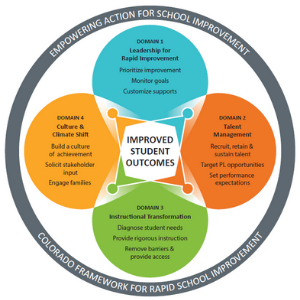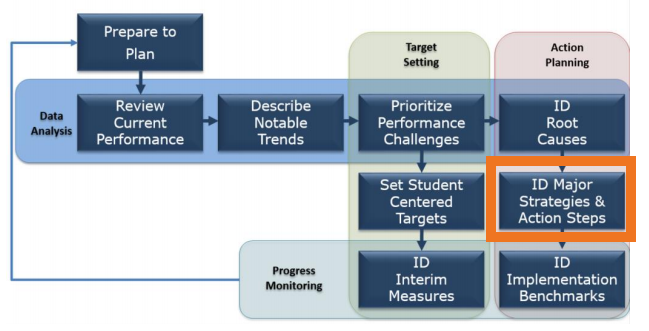You are here
Current UIP Major Improvement Strategy Guides
What is a Major Improvement Strategy Guide?
CDE has created a number of strategy guides to help schools and districts better understand what research says about strategies that are commonly used in the UIP. We have organized these strategy guides based on the 4 Domains of Rapid School Improvement (see Figure 1) These guides can be used for strategy selection or to determine areas of focus and action plans. More will be added as they are created.
When selecting Major Improvement Strategies, CDE recommends that schools and districts consider a range of factors.
The goal of these considerations is to identify strategies that:
-
meet identified needs
-
have a high level of evidence supporting their implementation
-
can be implemented effectively within the context of the school and district.
An intervention may be listed as a strategy or a strategy may encompass multiple interventions within it.
Implementation Guide
This guide incorporates insights and guidance from Implementation Science to provide research-based considerations for creating site-specific implementation plans. It is designed to be used in conjunction with other CDE-created resources, including the Strategy Guides, to help you design a site-specific school improvement action plan. This guidance can also be used to implement any well-defined educational strategy, as it presents the general practices that support strong strategy implementation in a variety of contexts.
- Implementation Guide (PDF)
- Implementation Guide Worksheets (Word Doc)
Browse the Current Strategy Guides
- Attendance Strategy Guide 2.0
- Coaching Strategy Guide 2.0
- Data Driven Instruction Strategy Guide 2.0
- Family-School-Community Partnerships (FSCP) Strategy Guide 2.0
- High Dosage Tutoring Strategy Guide 2.0
- Ninth Grade Success Strategy Guide 2.0
- Professional Learning Communities (PLC) Strategy Guide 2.0
- Trauma-Informed Education Strategy Guide 2.0
Browse Previous Strategy Guides
- Attendance Strategy Guide 1.0
- Coaching Strategy Guide 1.0
- Common Mission and Vision Strategy Guide 1.0
- Data Driven Instruction Strategy Guide 1.0
- Family-School-Community Partnerships (FSCP) Strategy Guide 1.0
- High Dosage Tutoring Strategy Guide 1.0
- Learning Loss Recovery Strategy Guide 1.0
- Multi-Tiered System of Supports (MTSS) Strategy Guide 1.0
- Positive Behavioral Interventions and Supports (PBIS) Strategy Guide 1.0
- Professional Learning Communities (PLC) Strategy Guide 1.0
- Summer School Strategy Guide 1.0
- Supporting ELs in GenEd Strategy Guide 1.0
- Trauma-Informed Education Strategy Guide 1.0
Purpose of Strategy Guides
Increased student progress, student achievements, and student milestones are impacted by the systems, structures and actions of school and district staff. The selection and effective implementation of strategies both play a key role in the ability to support and help students learn and grow. Substantial research goes into designing interventions, determining the key ingredients, and building the evidence base over multiple studies to conclude that an intervention is effective (Abry, Hulleman, & Rimm-Kaufman, 2015). Thus, when implementing an intervention in schools, it is important to implement it as intended, or with fidelity, to increase the likelihood of consistently obtaining the results you are looking to achieve (Harn et al., 2017; Harn, Parisi, & Stoolmiller, 2013). Although some degree of adaptation is anticipated, interventions implemented with higher fidelity tend to be more effective (Quinn & Kim, 2017). With that, these strategy guides are intended to provide a tool to not only ensure strategies districts and schools select are of the quality, they serve as a starting point for implementation.
Questions to Consider if a Strategy is Right for Your School/District
- Does this major improvement strategy focus on a priority performance challenge and associated root cause(s)?
- Are the expected outcomes of this major improvement strategy highly valued?
- Do key leaders support this major improvement strategy? Do key leaders have the capacity to lead the strategy ongoing?
- What are the skills and competencies needed to implement this major improvement strategy with fidelity? What support/professional development do staff members need to implement this strategy effectively?
- Are the time, effort and resources needed for implementation feasible for the staff involved?
Defining "Evidence Based Interventions"
Evidence-based interventions are practices or programs that have evidence to show that they are effective at producing results and improving outcomes when implemented. The kind of evidence described in ESSA has generally been produced through formal studies and research. Under ESSA, there are four tiers, or levels, of evidence:
Tier 1 – Strong Evidence: supported by one or more well-designed and well-implemented randomized control experimental studies.
Tier 2 – Moderate Evidence: supported by one or more well-designed and well-implemented quasi-experimental studies.
Tier 3 – Promising Evidence: supported by one or more well-designed and well-implemented correlational studies (with statistical controls for selection bias).
Tier 4 – Demonstrates a Rationale: practices that have a well-defined logic model or theory of action, are supported by research, and have some effort underway by an SEA, LEA, or outside research organization to determine their effectiveness.





Connect With Us





